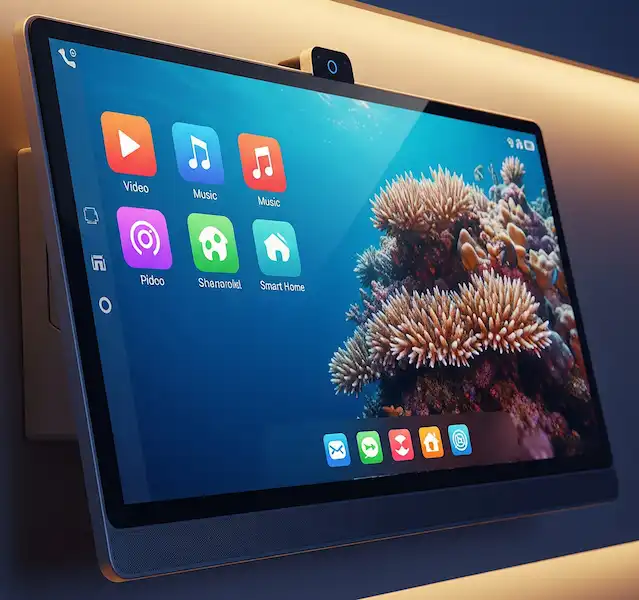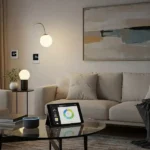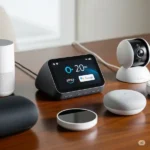Smart Display Devices: Your Visual Hub for a Smarter Home
In the evolving landscape of smart home technology, smart displays have emerged as a prominent and versatile device, bridging the gap between voice-controlled smart speakers and full-fledged tablets. More than just a speaker with a screen, these devices offer a visual interface for interacting with your digital assistant and managing your connected home. The smart display market is experiencing significant growth, with projections suggesting a substantial increase in market size over the next decade, driven by the increasing integration of AI and IoT in smart devices.
What are Smart Display Devices?
At their core, smart displays are smart speakers equipped with a touchscreen. This addition unlocks a whole new dimension of functionality, allowing you to not only hear information but also see it. Think of them as a command center for your smart home, providing both voice and visual control over your devices and services.
Smart displays represent a natural evolution from the voice-only smart speakers that first entered our homes. The addition of a screen was a game-changer, moving these devices beyond auditory responses to offer rich, interactive visual feedback, transforming them into true central hubs for the smart home.
Common smart display uses include:
- Smart Home Control: Manage compatible smart lights, thermostats, security cameras, door locks, and other connected devices with a tap or voice command.
- Visual Information: Get visual answers to your questions, such as weather forecasts, traffic updates, news headlines, and even step-by-step recipes.
- Communication: Make video calls to friends and family using integrated cameras and displays.
- Entertainment: Stream music and podcasts with accompanying visuals, watch videos from services like YouTube, and even catch live sports.
- Digital Photo Frame: Display your favorite photos, turning your smart display into a personalized digital picture frame when not in use.
- Timers and Alarms: Set and view multiple timers simultaneously, perfect for cooking or managing daily tasks.
- Security Monitoring: View live feeds from compatible security cameras, keeping an eye on your home, kids, or pets from another room.
The Usefulness of Smart Display Devices
The primary usefulness of smart displays lies in their ability to provide a more intuitive and comprehensive smart home experience. While smart speakers are excellent for audio-based interactions, the visual element of a smart display enhances functionality significantly.
Imagine this: instead of just hearing a recipe, you can see the ingredients list and follow along with visual steps. Instead of just hearing who’s at the door, you can see them on the screen. This visual feedback makes interactions more efficient and enjoyable, especially for tasks that benefit from a graphical interface. They also act as a central hub, simplifying the control of various smart devices that might otherwise require multiple apps on your phone.
Pros and Cons of Various Smart Display Devices
While the core functionality is similar across brands, different smart displays offer varying features and cater to specific ecosystems. The most popular players in this space are Amazon (Echo Show devices) and Google (Nest Hub devices), with other brands like Lenovo also offering options.
Amazon Echo Show Devices (e.g., Echo Show 8, Echo Show 10, Echo Show 15)
Pros:
- Alexa Integration: Seamlessly integrates with Amazon’s Alexa ecosystem, offering a vast array of skills and compatibility with numerous smart home devices.
- Fire TV Built-in (Echo Show 15 & 21): Larger models like the Echo Show 15 and 21 act as a smart TV, allowing you to stream content from popular services.
- Privacy Features: Many models include physical camera shutters for enhanced privacy.
- Variety of Sizes: Available in various screen sizes (5.5-inch to 21-inch) to suit different rooms and needs.
- Smart Home Hub: Newer models often include built-in Zigbee and Thread hubs for direct control of compatible smart home devices.
Cons:
- Google Services Limitations: May not offer the same seamless integration with Google services (like YouTube) as Google’s own devices.
- Audio Quality: While improving, some models may not deliver the highest fidelity audio compared to dedicated smart speakers.
- Vendor Dependency: Optimized for the Amazon ecosystem, potentially limiting interoperability with devices from other smart home platforms.
Google Nest Hub Devices (e.g., Nest Hub, Nest Hub Max, Pixel Tablet with Charging Speaker Dock)
Pros:
- Google Assistant Integration: Deep integration with Google Assistant, offering excellent search capabilities, calendar management, and personalized results via Voice Match.
- YouTube Integration: Native and seamless access to YouTube and YouTube Music.
- Sleek Design: Often feature a minimalist and aesthetic design that blends well with home decor.
- Sleep Sensing (Nest Hub 2nd Gen): The smaller Nest Hub can monitor your sleep patterns without a camera.
- Privacy Controls: Offers options to turn off the microphone and clear Google Assistant history.
- Pixel Tablet Versatility: The Pixel Tablet offers a unique hybrid experience, functioning as a portable Android tablet and a smart display when docked.
Cons:
- Camera on Nest Hub Max only: The smaller Nest Hub lacks a camera, limiting video call functionality to the larger Nest Hub Max.
- Fewer Built-in Smart Home Hubs: Historically, Google’s devices have relied more on Wi-Fi for connectivity, though newer models are incorporating Thread and Matter.
- Android Tablet Feel (Pixel Tablet): While versatile, the Pixel Tablet’s Android tablet interface might feel less optimized for a stationary smart display experience for some users.
Other Notable Mentions:
Beyond the dominant players, some brands like JBL (with their Link View, known for great audio) or Lenovo (with their Smart Frame for digital artwork) offer unique approaches. For those primarily seeking a tablet experience with docking capabilities, devices like the Google Pixel Tablet with its charging speaker dock offer a hybrid solution, blurring the lines between a traditional tablet and a stationary smart display. Even major appliance manufacturers like LG are integrating smart display features into products like their smart refrigerators, enabling visual control and communication directly from the kitchen appliance.
Deep Dive into the Technology of Smart Display Devices
Smart displays leverage a combination of sophisticated hardware and software to deliver their capabilities:
- System-on-Chip (SoC): These devices are powered by integrated SoCs, often based on ARM architectures. These combine the processor (CPU and sometimes a dedicated AI chip), memory (DRAM for active processes, Flash for storage), and power management into a single unit, allowing for efficient operation, compact design, and robust multitasking.
- Display Technology: Most smart displays use LCD (Liquid Crystal Display) panels with multi-touch capacitive interfaces, similar to smartphones. Advanced models may feature adaptive brightness and color tone sensors to adjust the display based on ambient light, ensuring optimal viewing and reducing eye strain. Resolution varies, with larger displays offering higher pixel densities for sharper images.
- Microphones and Voice Processing: Multiple microphones with far-field voice recognition and sophisticated noise filtering (using digital signal processing or DSP) allow the device to pick up voice commands accurately, even in noisy environments or from across a room. Natural Language Processing (NLP) then interprets these commands to generate appropriate responses.
- Connectivity:
- Wi-Fi: Provides high-bandwidth internet connectivity for streaming video, music, and data transfer. Most devices support Wi-Fi 5 (802.11ac) or Wi-Fi 6 (802.11ax) on both 2.4 GHz and 5 GHz bands.
- Bluetooth: Used for pairing with external speakers, headphones, or other accessories. Bluetooth Low-Energy (BLE) also supports mesh networking for certain smart home device communication.
- Matter and Thread: Newer devices are increasingly integrating Matter and Thread. Matter is an open-source, IP-based connectivity standard that allows smart home devices from different brands to work together seamlessly, acting as a “universal language” for smart home devices. Thread is a low-power, self-healing mesh networking protocol that provides a reliable and efficient way for Matter devices to communicate with each other, even if one device goes offline, improving reliability and range. These standards reduce reliance on proprietary hubs and improve interoperability.
- Image Processing Algorithms: Sophisticated algorithms enhance visual quality, reduce artifacts, ensure smooth playback of videos and animations, and optimize digital photo displays.
- AI and Machine Learning: Underlying AI and machine learning capabilities enable accurate voice recognition, personalized responses (e.g., via Voice Match), proactive suggestions, and predictive features based on user habits and preferences. This continuously improves the device’s understanding and responsiveness over time.
Tips for Using Smart Display Devices
To maximize the utility of your smart display, consider these tips:
- Strategic Placement:
- Kitchen: Ideal for recipes, timers, music, and quick information lookups while cooking.
- Living Room: Great for video calls, entertainment, and controlling central smart home devices.
- Bedroom: Useful as an alarm clock, night light, and for checking weather or news before getting up (consider models without cameras or with privacy shutters for this location).
- Home Office: Play background music or podcasts, manage your calendar, and make video calls.
- Customize Routines: Utilize routines to automate multiple actions with a single voice command. For example, a “Good Morning” routine could turn on lights, read the news, and give you the weather forecast.
- Explore Visual Features: Don’t just rely on voice. Actively use the touchscreen for Browse recipes, viewing security camera feeds, managing your calendar, and interacting with smart home controls.
- Leverage Voice Match (Google) or Voice Profiles (Alexa): If multiple people use the display, set up individual voice recognition so everyone gets personalized results for their calendars, music preferences, and more.
- Prioritize Privacy: Familiarize yourself with the privacy settings. Utilize physical camera shutters and microphone mute buttons when not in use. In addition, regularly review and understand the privacy policies of your device manufacturer. Be mindful of what data is collected and how it’s used, and periodically clear voice assistant history if your platform allows it. Consider features like ‘Guest Mode’ if available, to limit data collection when others use your device.
- Connect Smart Home Devices: Link all your compatible smart home devices to the display for centralized control. This eliminates the need to open multiple apps on your phone.
- Discover New Skills/Actions: Regularly explore new skills (Alexa) or actions (Google Assistant) to expand the functionality of your device.
- Use it as a Visual Aid for Learning: From quick definitions to step-by-step tutorials on YouTube, the visual element makes learning and troubleshooting much easier.
- Set Multiple Timers: The visual display of multiple active timers is incredibly helpful for multitasking in the kitchen or managing various activities.
While smart displays offer immense convenience, it’s worth noting their reliance on a stable internet connection and potential data consumption for video streaming. Users with extensive smart home setups involving less common or older protocols may also encounter integration challenges, requiring additional hubs or bridges.
Troubleshooting Common Problems of Smart Display Devices
Smart display devices are fantastic for bringing convenience and visual interaction into your home, but like all technology, they can encounter hiccups. Knowing how to troubleshoot common problems can save you a lot of frustration. Here’s a guide to the most frequent issues and their solutions:
Connectivity Issues (Wi-Fi, Bluetooth)
This is perhaps the most common category of problems, as smart displays rely heavily on a stable network connection.
Symptoms:
- “I can’t connect to Wi-Fi.”
- Device frequently disconnects from Wi-Fi.
- Slow responses or buffering during streaming.
- Bluetooth devices won’t pair or stay connected.
Troubleshooting Steps:
- Restart the Smart Display: Unplug it from the power outlet, wait for 30 seconds, and then plug it back in. This often resolves temporary network glitches.
- Restart Your Router and Modem: Power cycle your entire home network. Unplug both your router and modem, wait for 30 seconds, then plug the modem back in. Once the modem is fully online (usually indicated by stable lights), plug in your router.
- Check Wi-Fi Signal Strength: Is your smart display too far from your router or are there many obstructions (thick walls, large furniture)? Try moving the display closer to the router or consider a Wi-Fi extender/mesh system for better coverage.
- Reduce Wi-Fi Interference: Other electronics (microwaves, cordless phones, baby monitors) can interfere with your Wi-Fi signal, especially on the 2.4 GHz band. Try moving these devices away from your smart display and router.
- Switch Wi-Fi Bands (if available): If your router supports both 2.4 GHz and 5 GHz, try connecting your smart display to the 5 GHz band for faster speeds, but note that 5 GHz has a shorter range and struggles more with obstructions.
- Forget and Reconnect Wi-Fi: On your smart display’s settings, forget the current Wi-Fi network and then reconnect, re-entering the password.
- Check Router Settings: Ensure your router’s firmware is up to date. Also, check if any settings like MAC address filtering or a firewall might be blocking your smart display. Some routers have a “Smart Connect” feature that combines 2.4 GHz and 5 GHz bands, which can sometimes cause issues; temporarily disabling it might help.
- Bluetooth Troubleshooting: If a specific Bluetooth device isn’t connecting, try unpairing and re-pairing it. Ensure the Bluetooth device is in pairing mode and within range. Restarting both the smart display and the Bluetooth device can also help.
Unresponsive Touchscreen
A touchscreen that doesn’t react to your touches defeats a major purpose of a smart display.
Symptoms:
- Screen doesn’t respond to taps or swipes.
- Touches are inaccurate or “ghost touches” occur (screen registers touches you didn’t make).
Troubleshooting Steps:
- Clean the Screen: Dust, dirt, smudges, or even a build-up of oils can interfere with touch sensitivity. Use a soft, lint-free cloth (microfiber is best) to gently clean the screen. Avoid harsh chemicals.
- Restart the Device: A simple reboot can often clear temporary software glitches affecting the touchscreen.
- Remove Screen Protectors/Cases: If you have a screen protector or case, it might be interfering with the touch sensors. Try removing it to see if the problem resolves.
- Calibrate the Touch Screen: Many smart displays have a calibration option in their settings. This helps align the touch sensors accurately. Consult your device’s manual for specific instructions on how to do this.
- Check for Physical Damage: Inspect the screen for any cracks or visible damage. If physical damage is present, professional repair might be necessary.
- Update Firmware: Ensure your smart display’s software (firmware) is up to date, as updates often include bug fixes for performance issues, including touchscreen responsiveness.
“Hey Google” or “Alexa” Not Responding (Microphone Issues)
If your smart display isn’t hearing your voice commands, it’s frustrating.
Symptoms:
- Device doesn’t wake up when you say the wake word.
- Voice commands are not understood or misinterpreted.
- Video calls have no audio from your end.
Troubleshooting Steps:
- Check the Microphone Mute Switch: Most smart displays have a physical switch or button to mute the microphone for privacy. Ensure this switch is in the “on” or “unmuted” position. It’s often indicated by an orange or red color when muted.
- Restart the Device: Again, a quick reboot can resolve temporary software issues affecting the microphone.
- Speak Clearly and Within Range: Ensure you’re speaking clearly and are within the recommended distance from the device (usually within 5 meters).
- Check for Obstructions: Make sure the microphone holes on the device aren’t blocked by dust, debris, or other objects.
- Check Ambient Noise: Excessive background noise can make it difficult for your smart display to hear you. Try moving the device to a quieter location or reducing ambient noise.
- Retrain Voice Match/Voice Profiles: If your device has voice recognition features, try retraining your voice. This helps the device better understand your specific voice patterns.
- Google Nest Hub: Open the Google Home app > Settings > Assistant settings > Voice Match > Teach your Assistant your voice again.
- Amazon Echo Show: Open the Alexa app > More > Settings > Your Profile > Voice.
- Check Language Settings: Ensure the smart display’s language setting matches the language you are speaking.
Screen Display Problems (Black Screen, Flickering, Dimness)
Visual issues can hinder the smart display experience.
Symptoms:
- Screen is completely black, but the power light is on.
- Screen flickers or displays distorted colors/pixels.
- Screen is too dim or too bright, even after adjusting settings.
- Screen burn-in or ghosting (a persistent faint image).
Troubleshooting Steps:
- Check Power Connection: Ensure the power cable is securely plugged into both the smart display and a working wall outlet. Try a different outlet or a different power cable if possible.
- Restart the Device: A reboot can often clear display glitches.
- Adjust Brightness Settings: Check the display’s brightness settings, both through voice commands and on-screen menus. Many devices have adaptive brightness; ensure the sensor isn’t blocked.
- Check for Software Updates: Outdated firmware can sometimes cause display issues. Update your device to the latest software version.
- Check for Environmental Factors:
- Direct Sunlight/Bright Lights: Strong external light sources can make the screen appear dim or cause reflections. Try repositioning the display.
- Overheating: Ensure the device’s vents aren’t blocked, as overheating can lead to display malfunctions.
- Screen Flickering/Distortion: This can sometimes be a hardware issue, but first, try restarting the device. If the problem persists, it might indicate a more serious internal component problem.
- Screen Burn-in (OLED displays): While modern OLED displays have mitigation techniques, prolonged display of static images can cause burn-in. Use features like ambient mode with rotating photos or clock faces to minimize this risk.
App Crashes or Freezing
Sometimes specific apps or features within the smart display might malfunction.
Symptoms:
- An app (e.g., YouTube, Netflix, a smart home control app) crashes or freezes.
- The smart display becomes unresponsive when trying to open a specific feature.
Troubleshooting Steps:
- Restart the Device: This is the universal first step for most software-related issues.
- Clear App Cache/Data (if possible): Some smart displays allow you to clear the cache or data for individual apps. This can resolve issues caused by corrupted app data. Check your device’s settings for this option.
- Update the App/Firmware: Ensure the problematic app and your smart display’s operating system are up to date. App developers frequently release updates to fix bugs and improve performance.
- Reinstall the App (if removable): If the app is one you can install/uninstall (less common on smart displays than phones), try uninstalling and reinstalling it.
- Report the Issue: If the problem persists, consider reporting it to the device manufacturer or the app developer.
Additional helpful information
More about smart speaker devices – Smart Speaker Devices: Features, Comparison & Tips
Set up Home Assistant to work with your smart display device – Home Assistant Devices: Your Ultimate Local Smart Home Hub




